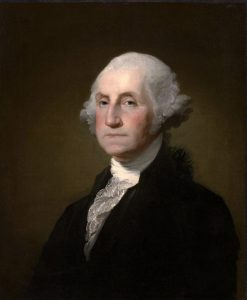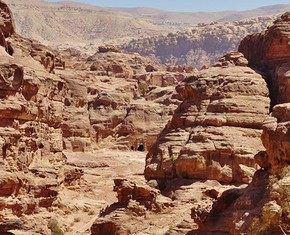The views expressed in our content reflect individual perspectives and do not represent the authoritative views of the Baha'i Faith.
When you were a kid, I’ll bet, you learned the names of your country’s past leaders, the people who once served as kings, queens, presidents or prime ministers.

George Washington
I know I did, anyway. As an American boy, I learned about George Washington, the man who could not tell a lie after he chopped down a cherry tree, the young country’s first president, the military hero of the American Revolution. Every elementary school student in the United States knows about Washington’s life. Few know, however, that George Washington was also a wealthy planter who wrote that he didn’t believe in the institution of slavery—but owned 200 slaves.
Which brings up a good question, one I definitely asked more than once in elementary school: why do we memorize the names of our past leaders, exalt their stations and study their lives? Why does history emphasize the famed and the named, but ignore the rest of us?
For that, you can probably credit Thomas Carlyle, the 1840s-era Scottish writer, philosopher and historian. He formulated the “Great Man Theory” in his book Heroes, Hero-Worship and the Heroic in History, writing that “The history of the world is but the biography of great men.” Carlyle believed that heroic, towering individuals shape and mold history, not only personally through their character attributes and the force of their will, but also through divine inspiration. In his book, he listed poets like Dante and Shakespeare, priests like Luther, kings like Cromwell and Napoleon, and even the prophet Muhammad, as the primary agents of change in the world.
So the Great Man theory put forth the concept that individual people or small groups of people, through the power of their character or their intellect or the force of their will, determine the course of history.
You have to admit, it’s a fascinating theory—that a few individuals fundamentally altered the course of history by living their lives in unique and powerful ways.
Carlyle’s primacy-of-great-men theory dominated the Victorian age, but then fell out of favor in the early 20th Century for a whole host of reasons—including its exclusion of women. Meanwhile, here are a few contemporary questions historians have asked related to the Great Man Theory: Do our national leaders really have much long-term influence? Do they have any? Do great men and great women really make history—or does history make them? Do our political leaders actually lead, or do they follow?
To answer those questions, we might contemplate Abraham Lincoln—the greatest American president by universal acclimation, who historians and the public agree preserved the country, defended democracy and freed the slaves. Lincoln’s leadership qualities, his skills at negotiation and managing crisis, and the integrity of his character all make him America’s most revered leader ever.
But historians also agree that Lincoln’s legacy didn’t last very long beyond his death. Even into the early 20th Century, four decades after Lincoln’s assassination, America’s Congress and its courts created and enforced so-called Jim Crow laws that functionally re-instituted slavery, at least economically. Racism roared back with a vengeance. The American South, although technically re-united with its mother country, continued to rebel, resisting integration with all its might. A century after Lincoln left us, we were still fighting the same battles. He had an impact, in other words, but a limited one.
The Baha’i teachings say that no temporal leader’s power can persist long after death inevitably calls:
All creatures are dependent upon God, however great may seem their knowledge, power and independence.
Behold the mighty kings upon earth, for they have all the power in the world that man can give them, and yet when death calls they must obey, even as the peasants at their gates. – Abdu’l-Baha, Paris Talks, pp. 19-20.
If you want to verify that concept, try this: see if you can come up with the name of the ruler, a few hundred years ago, who ruled the land where you now live. In my town in California, that probably involved a Spanish land-grant governor or a tribal Indian chief—and I have no idea who they were. People may have bowed down to those rulers at the time, or even venerated them as demigods for a while, but a long view of history entirely forgets and disregards them. Time buries everyone—the weak, the meek and the strong:
Know thou, verily, I say unto thee that the conditions of this mortal world, even if it be the kingship of the whole expanse of this globe, is ephemeral. It is an illusion. It is ended in nothing; neither does it contain any results, nor, in the estimation of God, is it equal to the wing of a mosquito.
Where are the kings and the queens? Where are the palaces and their mistresses? Where are the imperial thrones and jewelled crowns? Where are the mighty rulers of Persia, Greece and Rome? Verily, their palaces are in ruin and desolation, their thrones destroyed, and their crowns thrown to the dust. – Abdu’l-Baha, Star of the West, Volume 3, pp. 252-253.
Here’s the central question about the Great Man Theory: do we have any evidence that the most influential people in our collective history really caused change? If you believe in causality, then you know that every great man or woman had significant historical forces acting upon them, and were themselves the effects of those forces.
This whole concept—the impact and lasting influence of any one individual person on everyone else—is a fascinating and controversial one. We’ll come back to it at the end of this series of essays, but for tomorrow, let’s delve a little deeper into the Baha’i teachings to see what the Great Man theory of history looks like when viewed from afar.
















Comments
Sign in or create an account
Continue with Googleor